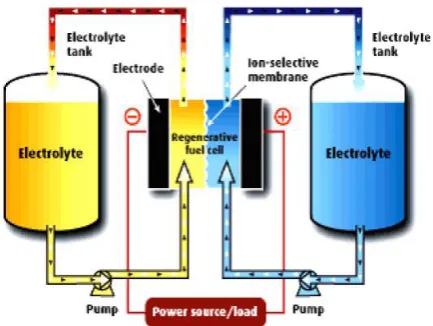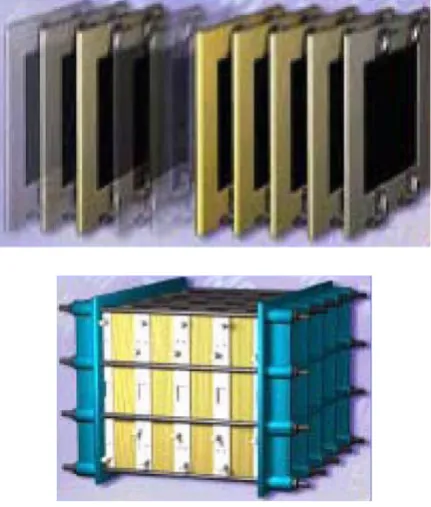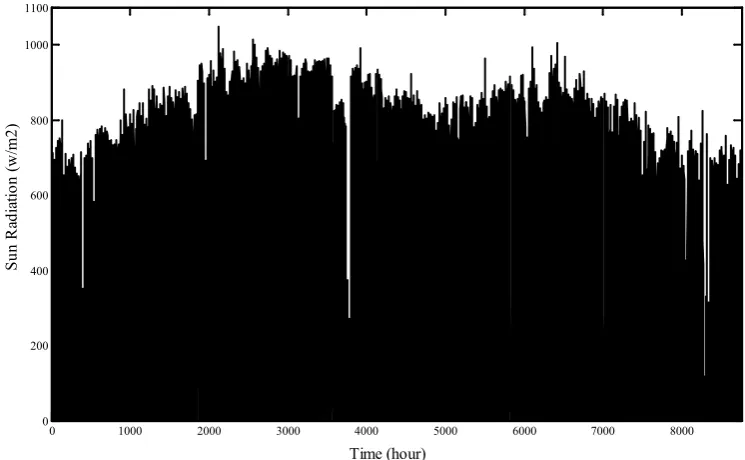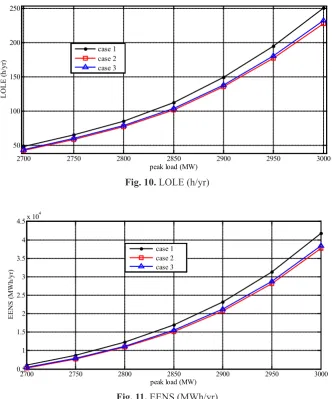Research Journal
Volume 10, No. 32, Dec. 2016, pages 198–205
DOI: 10.12913/22998624/65109 Research Article
RELIABILITY EVALUATION OF RENEWABLE ENERGY-BASED POWER SYSTEM
CONTAINING ENERGY STORAGE
Amir Ghaeedi1, Erfaneh Noroozi1
1 Islamic Azad University of Dariun Branch, Dariun, Islamic Republic of Iran, e-mail: erfanehnoroozi@iaudariun.ac.ir
ABSTRACT
In recent years, renewable energy based power plants, especially wind and solar farms are increasingly installed and operated for electric power generation. Uncer-tainty nature associated to the generated power of these power plants, arisen from
variability of wind speed or solar radiation, effects on different aspects of power sys -tem such as reliability, operation, dynamic and so on. Energy storages in connection with renewable power plants can reduce the variability and uncertainty nature of
these renewable resources. In recent years the flow batteries such as vanadium redox (VR) with large capacities are developed and so in this paper effect of this
large-capacity energy storages on the reliability performance of power system contain-ing large-scale wind and photovoltaic (PV) farms are investigated. The renewable
energy-based power plants and also energy storages are different from conventional
units, so, for study of power system containing these resources new methods and techniques must be developed. To this end in this paper for reliability evaluation of renewable-energy based power system containing energy storage, an analytical ap-proach is proposed. This apap-proach can be employed both in planning and also opera-tion studies of the power system when large scale wind and photovoltaic farms with
energy storages exist. Data associated to wind speed of Manjil and solar radiation of
Jask regions both in Iran are utilized for studying the reliability evaluation of RBTS and also IEEERTS in planning phase.
Keywords: reliability evaluation, renewable resources, vanadium redox batteries,
fuzzy clustering method.
INTRODUCTION
Renewable energies specially wind and so-lar, are increasingly used in the power system because of the availability, clean and no pollut-ant nature and free operation cost of them. The output power of wind and photovoltaic (PV) farms is dependent on the wind speed and solar radiation. Since the wind speed and also the so-lar radiation continuously change and are not ac-curately predictable, the output powers of these renewable resources are variable. To overcome this challenge and for reducing the intermittency of the output power of these resources, energy storages such as batteries [1-8], pumped storage [9], a system containing water electrolyze, hy-drogen tank and fuel cell [10-15], ultra-capacitor
[16], superconducting magnetic energy storage
[17], compressed air energy storage [18] and fly -wheel [19] can be used in connection with these
power plants. Amongst these storages, flow bat
-teries such as vanadium redox type are made in
large capacities and can be used in large-scale power system [8].
The intermittent nature associated to the
out-put power of renewable resources, effect on the different aspects of power system such as reli -ability, power quality and so on that can be in-vestigated. To this purpose, new methods and techniques must be developed. Power system re-liability is one of the important aspect that used in planning and operation studies of the power system. In this paper an analytical approach for reliability evaluation of renewable-energy based
hybrid or distributed generation systems [1–7].
Besides in these papers, Monte Carlo simulation
method is used for load, wind and solar genera-tion modelling. In [8], reliability evaluagenera-tion of power system containing wind farms and vana-dium battery storages in HLI is investigated. In
this paper, Monte Carlo method is used for simu -lation of wind output power, load and the state of battery. However the long time consumption and the large required volume of memory are the main drawback of this technique. In this regard this paper proposes an analytical approach which
does not have these difficulties.
The main idea of this paper is developing a multi-state reliability model for renewable re-sources connected to the energy storage. Since, the operation of the energy storage is dependent on the operation of renewable units, the reli-ability model is not independently developed to renewable units. Based on this model, simulta-neously, the system composed of the renewable units and battery storages in one block, is mod-eled. The proposed reliability model would be similar to the conventional units, but with de-rated states. For determining the suitable num-ber of states and also the capacity of them, it is utilized from the robust fuzzy c-means cluster-ing method. The resulted multi-state reliability model associated to the system including renew-able resources and battery storages can be used for reliability evaluation of power system in HLI in planning or operation phases.
STRUCTURE OF VANADIUM REDOX
BATTERIES
The power range kW-MW, energy storage capacity kWh-10 MWh, high efficiency more
than 75 percent, long life time 10-20 years, deep discharge ability, fast response, environmental friendly nature, full charging and de-charging capacity in very short time, charging and de-charging cycle more than 10000 times, lead to
the growth of vanadium redox batteries appli
-cation in recent years [20–23]. Due to the good
the valence change of the species in the electro-lyte that circulate through the cathode and the
anode, which are separated by an ion exchange
membrane. The total reaction is occurred in the two main tanks and the stored electrolytes are reserved in the two large tank. The electrolytes are circulated between small and large tanks by a pump [20–23].
The total VR, anode and cathode reactions are given in (1), (2) and (3), respectively. The VR batteries are composed of several cell modules and each module is composed of several single cells that is shown in Figure 2.
+ + + +
+ +V +H O↔VO +V + H VO
reaction Total
2 :
2 2 2
3
2 (1)
+ + + ↔ 2 3
: V e V Cathode
(2)
+ + + +
++V +H O↔VO +V + H VO
reaction Total
2 :
2 2 2
3
2 (3)
The output power of the VR battery is DC
and for transferring the electrical power between
VR battery and the AC grid, an inverter and also
a control unit for determining the charge or de-charge states are required.
THE RELIABILITY MODEL OF VR
BATTERIES
The Marco model of an element with up and
down states is shown in Figure 3. In this model the element is failed (transferred from up state to
the down state) with failure rate λc and is repaired
(transferred from down state to the up state) with repair rate µc [24]. In this paper this two-state
reliability model is considered for different com -ponents of a VR battery including cells, inverter and control unit. The failure of each three compo-nents results in the failure of system and so from reliability point of view, these components are in series with each other (as shown in Figure 4) and the reliability parameters of the equivalent model are determined by (4) [24].
∑
∑
∑
=∑
==
i i i i
i eq
r r
U U
λ λ λ
λ , , (4)
THE RELIABILITY MODEL OF THE SYSTEM
COMPOSED OF THE RENEWABLE-BASED
FARM CONNECTING TO THE VR BATTERY
The efficiency of storing electrical energy in the
VR battery and transferring the power to the grid in
the de-charging state is less than 100 percent and storing the generated power of conventional units with high operation costs is not economic. How-ever with growth of penetration level of renewable resources such as wind and solar farms with free operation cost, it is economic that stores the elec-trical energy of wind and photovoltaic (PV) farms in the VR batteries when the power generation of these renewable energy-based units is more than
the required loads. In this circumstance the extra
power of wind and PV farms is stored in the VR battery and when the generated power of renew-able energy-based units with free operation costs is less than the required loads, these batteries are de-charged and supplied the existing loads. Thus,
the operation of the VR battery is dependent on the operation of renewable energy-based farms and in this paper the reliability model of a system contain-ing the wind or PV farms connectcontain-ing to the battery storages is developed.
For reliability modelling of the system con-taining renewable resources connected to the energy storage, the hourly output power of the system in one or more years must be available. When the reliability model of the system, based on the historical output power of the system, is determined, the limitation of the system including failures of the components of renewable units and
storage system, efficiency of the storage system, maximum and minimum capacity of the battery,
charging and de-charging speed of the battery are simultaneously considered.
The historical data of the output power of the
system has numerous different values resulted in
Fig. 2. The structure of module and cells of a VR battery
Fig. 3. Two-state Marco model
ity of these states are determined by optimization
of the objective function given in (5) [25].
i k c
1 i
n
1 k
m ik x v u
J =
∑∑
−= =
(5)
In (5), n output powers are clustered into the
C clusters, where xk is the output power of the sys-tem in hour k, vi is the center of ith cluster, uik is
Fuzzy degree to which xk belongs to the ith cluster. For adequacy studies of a power system containing the renewable resources connected to the VR battery energy storage, capacity
out-age probability table (COPT) of the generation
system composed of the two-state reliability model of conventional units and multi-state reli-ability model of the system containing wind or solar unit connected to the VR battery as shown
in Figures 5 and 6 is achieved. Convolving the resulted COPT of the system (generation model)
and the load model, the adequacy indices of the system can be determined. The calculated
ade-quacy induces can be used for generation expan -sion planning of the power system containing the renewable resources connected to the large-capacity VR batteries.
NUMERICAL RESULTS
In this section the adequacy studies of two well-known test systems i.e. RBTS and IEEE-RTS when wind and PV farms connected to the VR batteries are added to these systems are
per-formed. The specification of the renewable farms
is considered as below:
• Wind farm: a 30 MW wind farm with failure
and repair rates 5 and 87.6 occ./yr, composed of the 6 turbines V90, is considered to be
in-stalled in Manjil region of Iran. The historical wind speed data of the Manjil region in 2014
is presented in Figure 7. The output power of the farm can be determined based on the pow-er curve of the turbine Vestas90.
• PV farm: a 100% reliable 30 MW PV farm
is considered to be installed in Jask region of
Iran and generated the nominal power in solar radiation 900 W/m2. The historical solar radia-tion data of Jask region in 2014 is presented in Figure 8.
• VR batteries: two 5 MW VR batteries with capability of 10 MWh stored energy and ef
-ficiency 75%, composed of 500 batteries with
10 kW capacity are connected to the wind and PV farms. The failure and repair rates are considered to be 0.5 and 87.6 occ./yr. and the up and low capacities of the battery are not limited.
Wind farm
Fig. 5. Adequacy studies of a power system contain-ing wind farms connected to the VR batteries
Conventional
generation
Load
PV farm
Energy storage
Since the historical data of the system con-taining wind farm connected to the VR battery and also the PV farm connected to the VR bat-tery are not available, in this paper, generation
of output power of the system is done by Mon
-te Carlo simulation with 100 years’ time span.
In this simulation the IEEE-RTS load pattern as shown in Figure 9 is used.
The resulted data from the Monte Carlo simulation is used as input data of the FCM
technique and the reliability models of system containing wind farm connected to the VR tery and also PV farm connected to the VR
bat-tery are extracted and shown in Table 1. This
reliability model can be used for adequacy studies of two test systems.
RBTS CASE STUDY
The RBTS is composed of 11 generation units
with total capacity 240 MW. The specification of
generated units and reliability parameters of them is given in [26]. The load duration curve is con-sidered to be a straight line from 100 to 60 percent
of the maximum peak load. For adequacy evalu -ation of the system three cases are considered as below: case 1 is the original RBTS and in cases
2 and 3, respectively a 30 MW wind farm con
-nected to the 5 MW VR battery and a 30 MW PV farm connected to the 5 MW VR battery are add -ed to the RBTS. Two important indices i.e. loss
of load expectation (LOLE) and expected energy not supplied (EENS) considering different peak
loads, are calculated and shown in Tables 2 and 3. As can be seen in these tables, addition of the
re-Fig. 7. The historical wind speed data of Manjil region in 2014
0 1000 2000 3000 4000 5000 6000 7000 8000
0 200 400 600 800 1000 1100
Time (hour)
Sun R
adi
at
ion (
w
/m
2)
newable energy-based generation units connected
to the VR batteries can significantly improve the
reliability performance of the power system.
IEEE-RTS CASE STUDY
The IEEE-RTS is a large power system and can be modeled as a real power system in com-pare to the RBTS. In this part adequacy studies of this system with addition of the renewable energy-based farms connected to the VR
batter-ies is performed. The specification of the
IEEE-RTS generation units is given in [27]. In this stage three cases as below are considered: case 1 is the original IEEE-RTS and in cases 2 and 3,
respectively a 30 MW wind farm connected to the
5 MW VR battery and a 30 MW PV farm con
-nected to the 5 MW VR battery are added to the IEEE-RTS. The LOLE and EENS of three cases
are calculated and presented in Figures 10 and 11.
As can be seen from these figures, the reliability
of power systems is improved with addition of the renewable energy-based generation units con-nected to the large capacity VR batteries.
0 1000 2000 3000 4000 5000 6000 7000 8000 9000 60
80 100 120
time (h)
pe
ak
Fig. 9. IEEE-RTS load pattern
Table 1. The reliability model of renewable energy-based systems connecting to the VR battery
Wind farm + VR battery PV farm + VR battery
Cluster number Cluster center (MW) Probability Cluster center (MW) Probability
1 33.6 0.3357 32.9 0.1280
2 28.7 0.0597 28.5 0.1551
3 22.6 0.0558 23.5 0.0881
4 16 0.0528 16.6 0.0603
5 9.7 0.0806 10.5 0.0567
6 5.7 0.1159 3.8 0.4667
7 3.6 0.2995 0.2 0.0451
Table 2. LOLE (h/yr) Peak load
(MW) Case 1 LOLE (h/yr)Case 2 Case 3
170 3.5714 1.0958 1.4113 175 4.9676 1.8158 2.2320 180 6.3579 2.6020 3.1120 185 11.1228 3.7126 4.5694 190 15.6532 5.9110 7.2873 195 20.7491 8.5359 10.3527 200 26.3562 11.7494 13.9025
Table 3. EENS (MWh/yr) Peak load
(MW)
EENS (MWh/yr)
CONCLUSIONS
In this paper an analytical method is intro-duced for adequacy analysis of a power system containing the large-scale renewable energy-based farms connected to the large capacity VR
batteries. Due to the uncertainty nature of wind
speed and solar radiation, the output power of wind and PV farms are variable in times and so for decreasing the intermittency of these farms, energy storages can be connected to these plants. In this paper VR batteries with high capacity con-nected to the wind and PV farms, are considered; and a multi-state reliability model based on the output power historical data is developed for them. This model is used for adequacy studies of RBTS and IEEE-RTS when wind and PV farms connected to the VR batteries are added to them.
The COPT of the system is constructed from the
two-state reliability model of conventional units
and multi-state reliability model of system com-posed of wind or PV farms connected to the VR batteries. For reducing the number of the states in the reliability model of renewable energy-based
farms, fuzzy C-means clustering method is em -ployed and the number of clusters as well as the capacity of the states is determined.
It is deduced from the numerical results that addition of the large-scale renewable energy-based power plants can improve the reliability in-dices of the power system when the VR batteries are connected to them.
REFERENCES
1. Liu X. and S. Islam. Reliability evaluation of a wind-diesel hybrid power system with battery bank using discrete wind speed frame analysis. IEEE
In-ternational Conference on Probabilistic Methods
Applied to Power Systems, 2006.
2700 2750 2800 2850 2900 2950 3000 50
100 150 200 250
peak load (MW)
LO
LE
(h
/y
r)
case 1 case 2 case 3
Fig. 10. LOLE (h/yr)
2700 2750 2800 2850 2900 2950 3000 0.5
1 1.5 2 2.5 3 3.5 4 4.5x 104
peak load (MW)
EE
N
S
(M
W
h/
yr)
case 1 case 2 case 3
generation system. IEEE Electrical Power &
En-ergy Conference, 2009.
4. Giraud F. and Zyiad M. Salameh. Steady-state per -formance of a grid-connected rooftop hybrid wind-photovoltaic power system with battery storage.
IEEE Transactions on Energy Conversion, 16(1),
2001, 1–7.
5. Lu, Ming-Shun, et al. Combining the wind power
generation system with energy storage equipment.
IEEE Industry Applications Society Annual Meet -ing, 2008.
6. Völler S., Al-Awaad A-R. and Verstege J.F. Wind farms with energy storages integrated at the
con-trol power market. CIGRE/IEEE PES Joint Sym -posium on Integration of Wide-Scale Renewable
Resources Into the Power Delivery System, 2009.
7. Barote L., Georgescu M. and Marinescu C. Smart
storage solution for wind systems. Power-Tech IEEE conference, Bucharest, 2009.
8. Hu P., Karki R. and Billinton R. Reliability evalu-ation of generating systems containing wind power
and energy storage. IET Gener- Transm- Distrib,
3(8), 2009, 783–791.
9. Gao Feng, Arne Hallam and Chien-Ning Yu. Wind
generation scheduling with pump storage unit by collocation method. IEEE Power and Energy
Soci-ety General Meeting, 2009.
10. Zahedi A. Technical analysis of an electric power system consisting of solar PV energy, wind power, and hydrogen fuel cell. IEEE Power Engineering
Conference, Australasian Universities, 2007.
11. Dehghan S., et al. Optimal sizing of a
hydrogen-based wind/PV plant considering reliability
in-dices. IEEE International Conference on Electric Power and Energy Conversion Systems, 2009.
12. He Aishan, Zhuoyong Yan and Weidong Gu. Re -search on non-grid-connected wind power systems used for hydrogen production from
water-elec-trolytic. IEEE World Non-Grid-Connected Wind Power and Energy Conference, 2009.
13. Miller A.I. and Duffey R.B. Integrating large-scale
cogeneration of hydrogen and electricity from wind
and nuclear sources (NUWIND TM). Proceedings of the 2008 International Congress on Advances in
Nuclear Power Plants, 2008.
version, 23(3), 2008, 957–967.
16. Chen S.X. and Gooi H.B. Capacitor planning of
power systems with wind generators and PV
ar-rays. TENCON IEEE Region 10 Conference, 2009.
17. Jung Hee-Yeol, et al. A study on the operating characteristics of SMES for the dispersed power
generation system. IEEE Transactions on Applied Superconductivity, 19(3), 2009, 2028–2031. 18. Lerch E. Storage of fluctuating wind energy. IEEE
European Conference on Power Electronics and
Applications, 2007.
19. Mansour Mohamed, Mansouri M.N. and Mimou
-ni M.F. Performance Evaluation of a Flywheel
Energy-Storage System Associated to a Variable-Speed Wind Generator. Sustainability in Energy and Buildings, Springer Berlin Heidelberg, 2012, 201–211.
20. Miyake S. and Nobuyuki T. Vanadium redox-flow
battery for a variety of applications. IEEE Power
Engineering Society Summer Meeting, 1, 2001.
21. Shibata A. and Kanji S. Development of vanadium redox flow battery for electricity storage. Power
Engineering Journal 13(3), 1999, 130–135. 22. Skyllas‐Kazacos M. et al. Recent advances with
UNSW vanadium‐based redox flow batteries. In -ternational Journal of Energy Research, 34(2), 2010, 182–189.
23. Shibata A., Sato K. and Masato N. Development of vanadium redox flow battery for photovoltaic gen
-eration system. IEEE Photovoltaic Energy Conver -sion, 1994.
24. Billinton R. and Ronald N.A. Reliability Evalua-tion of Power Systems. 2nd EdiEvalua-tion, Plenum Press,
New York and London, 1994.
25. Ghaedi A. et al. Toward a comprehensive model
of large-scale DFIG-based wind farms in adequacy
assessment of power systems. IEEE Transactions on Sustainable Energy, 5(1), 2014, 55–63.
26. Billinton R., et al. A reliability test system for edu-cational purposes-basic data. IEEE Transactions on Power Systems, 4(3), 1989, 1238–1244.
27. Subcommittee, Power Market. IEEE reliability test





